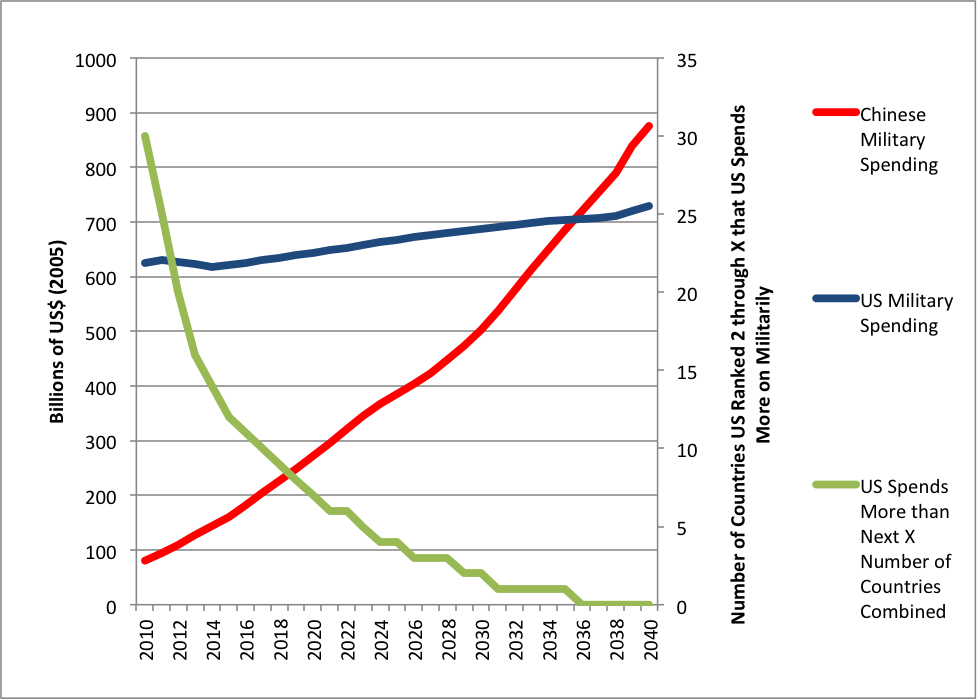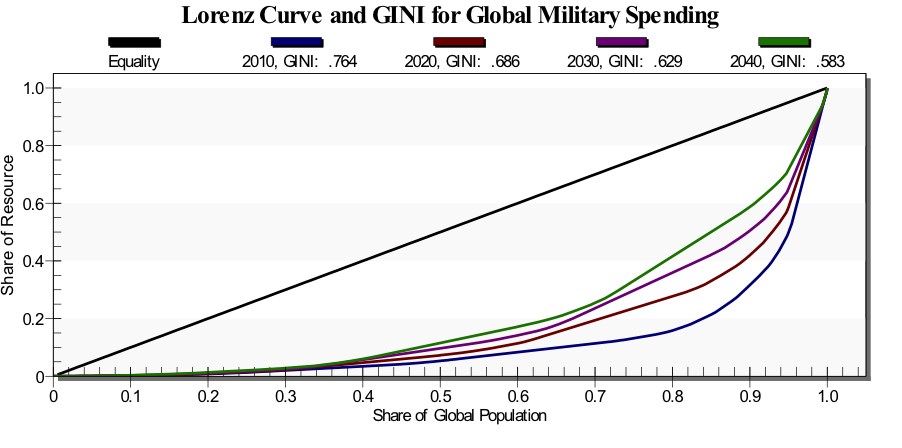
Chinese military spending is up. American military spending is down.
That is certainly the takeaway from the recent news cycle, which has identified an increase in Chinese military spending at the People's Congress and a decline in U.S. military spending due to the "sequester."
But what are the broader trends and implications of these shifts in military resource allocation? Here at the Frederick S. Pardee Center for International Futures, we model relationships and trends over long time horizons for hundreds of variables to explore implications for policy planning. Using the International Futures (IFs) model, we have represented the development of 183 countries to 2100.
The United States is far and away the largest military spender in the world. In 2010, we calculated that the United States spent more than the next 30 countries combined.
However, things are shifting rapidly.
The line graph below shows three forecasts. The blue line represents military spending in the United States to 2040. The red line shows military spending in China. We expect the Chinese to spend more than the Americans in less than three decades.
 The third forecast -- shown in green -- measures the next number of countries, considered cumulatively, that the United States outspends. For example, in 2010 we calculated that the United States spent more than the next 30 countries combined (that's the second highest spender through the 31st highest spender). This is shifting dramatically. By the end of this decade we forecast that the United States will only spend as much as the next six countries combined. This is a part of a global shift towards increasing equality in military spending. The Lorenz Curve graph below demonstrates this, measuring inequality in the distribution of military spending. The Lorenz Curve is used to calculate the GINI coefficient, a measure of inequality (it is actually a measure of the space between the horizontal line stretching from the bottom left to the top right and the curve).
The third forecast -- shown in green -- measures the next number of countries, considered cumulatively, that the United States outspends. For example, in 2010 we calculated that the United States spent more than the next 30 countries combined (that's the second highest spender through the 31st highest spender). This is shifting dramatically. By the end of this decade we forecast that the United States will only spend as much as the next six countries combined. This is a part of a global shift towards increasing equality in military spending. The Lorenz Curve graph below demonstrates this, measuring inequality in the distribution of military spending. The Lorenz Curve is used to calculate the GINI coefficient, a measure of inequality (it is actually a measure of the space between the horizontal line stretching from the bottom left to the top right and the curve).
According to the graph below, in 2010, 80 percent of the world's countries were responsible for less than 20 percent of the world's military spending. By 2040 -- the green line -- this share grows to nearly 50 percent of world military spending. In other words, it's not that the U.S. military spending isn't still massive and growing (see the graph above). It's just that the rest of the world is catching up. 
The implications of this transition for policymakers -- whether in the United States or not -- are seismic. The next few decades will see a dramatic shift in the character and composition of the international system. The United States will remain a global leader, but military might will become increasingly diffuse, and multilateral institutions -- still rooted in Western values -- will become even more important.
The views held in this blog post are of the author and do not in any way reflect the views of the Frederick S. Pardee Center for International Futures, its faculty or staff.